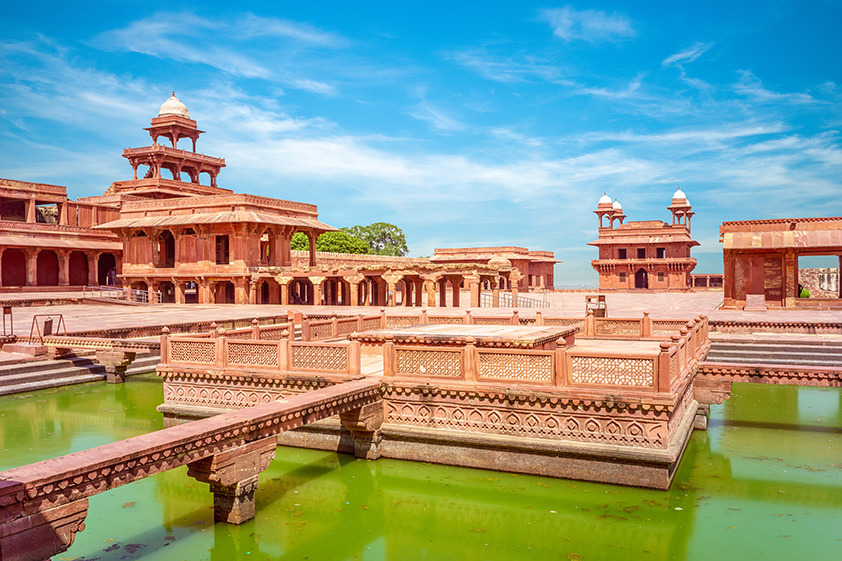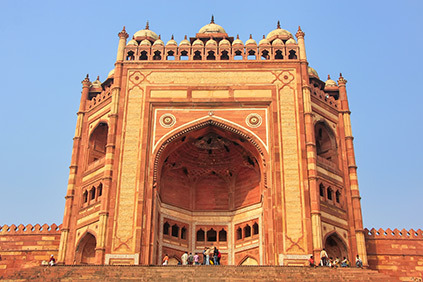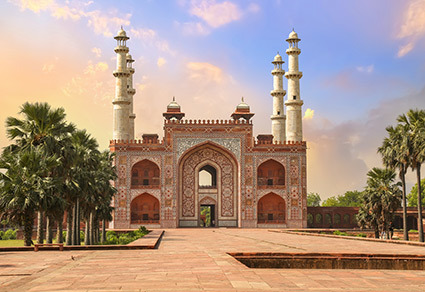Read. Imagine. Travel.
Namaste! As they say “Be strong because things will get better. It may be stormy now, but it never rains forever.” So let’s all take a moment to remind our hearts that we are in this together. The world will get better, and trying new things and seeking new adventure will be exhilarating like never before!
Meanwhile, we hope that our virtual travel treats are keeping you inspired and exhilarated. You are in for a delight in this edition too as we will be focussing on “Akbar the great- A gem of Gunpowder Empire”
One of the Mughal era's strongest personalities, Akbar strengthened the roots of the Mughal Empire in India. As a third emperor of the Mughal Dynasty he took it to new heights in his 50 years of rule that lasted from 1556 to 1605 AD. His wise political decisions and policies let the era witness economic stability, expansion of territory, revolutionary changes, and religious and cultural harmony. It was during his regime that the Mughal Empire grew three fold in its territorial size and wealth. Having a powerful military system and most innovative firearms, the Mughal Empire, during his reign, was also considered as one of the three ‘Gunpowder Empires’ (the other two were the Ottoman and the Safavid dynasty). Unlike other Mughal rulers of his lineage, Akbar was the most favourite ruler among his subjects because of his favourable and religiously tolerant policies towards all religions. Some of his policies worth a mention are abolishing sectarian tax for non-Muslims, funding the construction of places of worship of other religious faiths, allowing the celebrations and participation of people in religious festivals, appointment of non-Muslims for higher posts in civil as well as military departments, etc.

Akbar was a great admirer of art and literature and patronized them whole heartedly despite being an illiterate himself. In an era, when education for all was a far cry to many, Akbar created a library of over 24,000 volumes written in Sanskrit, Persian, Urdu, Arabic, Greek, Latin, and Kashmiri, consisting of works of numerous prominent scholars, artists, calligraphers, scribes, translators etc. On the architecture front, he has some great contributions that are still standing as a testimony to his imperialism. The large bulbous domes, corners adorned with leaning minarets, and large gateways leading to huge halls with delicate ornamentation are some of the characteristics followed in the Mughal architecture. With a heavy usage of red sandstone and blend of Indian, Persian, Turkish, and Islamic influence, Mughal architecture flourished during the reigns of Akbar and reached its zenith during the era of Shahjahan, the fifth emperor of Mughal Dynasty and grandson of Akbar. The accomplishments credited to Akbar, accorded him the epithet "The Great". Take a glimpse of Mughal architecture at Fatehpur Sikri in this short video.
INTERESTING FACT: The court of Emperor Akbar was also famous for its Navratnas (nine gems). These include men of genius with subject matter expertise like finance and revenue, defence, foreign affairs, home affairs, education, religion, cultural affairs etc.
Let's take a look at some of the structures erected by Akbar:
AGRA FORT (1565-1573)
The strategic location of Agra convinced Akbar to build his capital here and built the Agra fort over the ruined brick fort named Badalgarh. Typically built in Akbari style with red sandstone, it was completed in eight years, engaging around 4000 labourers. The fort has four gates and is believed to have around 500 structures within the complex initially, but later some were demolished by Shahjahan and some by the British. Today only 30 structures are surviving. Unlike Akbar, Shahjahan preferred white marble over Red sandstone, and therefore one will find few white structures built by Shahjahan inside the fort.

Within the complex enclosed by a 2.5 kms long and 22 meters high wall, one will find many palaces or structures added by the later rulers, but among all of them the Akbari style of architecture stands out distinct.
The UNESCO world heritage site listed fort was built alongside the course of Yamuna and had its outer walls surrounded by 09 meters wide and 10meters deep moat. Interestingly, the cell inside the fort, where Shahjahan was imprisoned, when he was captured by his son Aurangzeb, provided him an uninterrupted view of Taj Mahal, which he had built in memory of his beloved queen. A visit to the fort, which is semi-circular in shape, gives one a chance to understand the evolution of Mughal architecture even though several structures inside the fort were added by successive rulers.


 Within the complex enclosed by a 2.5 kms long and 22 meters high wall, one will find many palaces or structures added by the later rulers, but among all of them the Akbari style of architecture stands out distinct.
Within the complex enclosed by a 2.5 kms long and 22 meters high wall, one will find many palaces or structures added by the later rulers, but among all of them the Akbari style of architecture stands out distinct.
 The city of Fatehpur Sikri, which is also listed as a UNESCO world heritage site, was founded by Akbar and was named Sikri initially. The birth of his son Jehangir, predicted by the Sufi Saint Sheikh Salim, a native of Sikri, led him to build a religious compound dedicated to the saint. Later Akbar decided to build a walled city to commemorate his victory in Mewar and Ranthambore. The city of victory (as Fateh is called), thus built-in red sandstone, has many religiously and secularly important structures.
The city of Fatehpur Sikri, which is also listed as a UNESCO world heritage site, was founded by Akbar and was named Sikri initially. The birth of his son Jehangir, predicted by the Sufi Saint Sheikh Salim, a native of Sikri, led him to build a religious compound dedicated to the saint. Later Akbar decided to build a walled city to commemorate his victory in Mewar and Ranthambore. The city of victory (as Fateh is called), thus built-in red sandstone, has many religiously and secularly important structures.
 Being impressed by the strategic location of Prayaga city, Akbar built a fort here and renamed the city as Illahabas or Ilahabad (City of Gods) which later became Allahabad in an anglicized version. It is believed to be the largest fort commissioned by him. The majestic fort known for its magnificent craftsmanship has three galleries. There are many structures in the complex worth admiring, including an underground temple. Only a small part of the fort is open for the visitors.
Being impressed by the strategic location of Prayaga city, Akbar built a fort here and renamed the city as Illahabas or Ilahabad (City of Gods) which later became Allahabad in an anglicized version. It is believed to be the largest fort commissioned by him. The majestic fort known for its magnificent craftsmanship has three galleries. There are many structures in the complex worth admiring, including an underground temple. Only a small part of the fort is open for the visitors.
 The construction of the tomb complex spread in around 119 acres was initiated in 1605 and completed by 1613. This four tiered pyramid structure was built in Akbar's favorite red sandstone and has a tomb in the center of the vast gardens laid out in Charbagh style typical to Mughal architecture.
The construction of the tomb complex spread in around 119 acres was initiated in 1605 and completed by 1613. This four tiered pyramid structure was built in Akbar's favorite red sandstone and has a tomb in the center of the vast gardens laid out in Charbagh style typical to Mughal architecture.
 We can conduct a virtual destination awareness training program for your team or yourself or a virtual tour for your clients. Let us know the destination of your interest along with your convenient date / time and we will be happy to set up a program for you.
We can conduct a virtual destination awareness training program for your team or yourself or a virtual tour for your clients. Let us know the destination of your interest along with your convenient date / time and we will be happy to set up a program for you.


